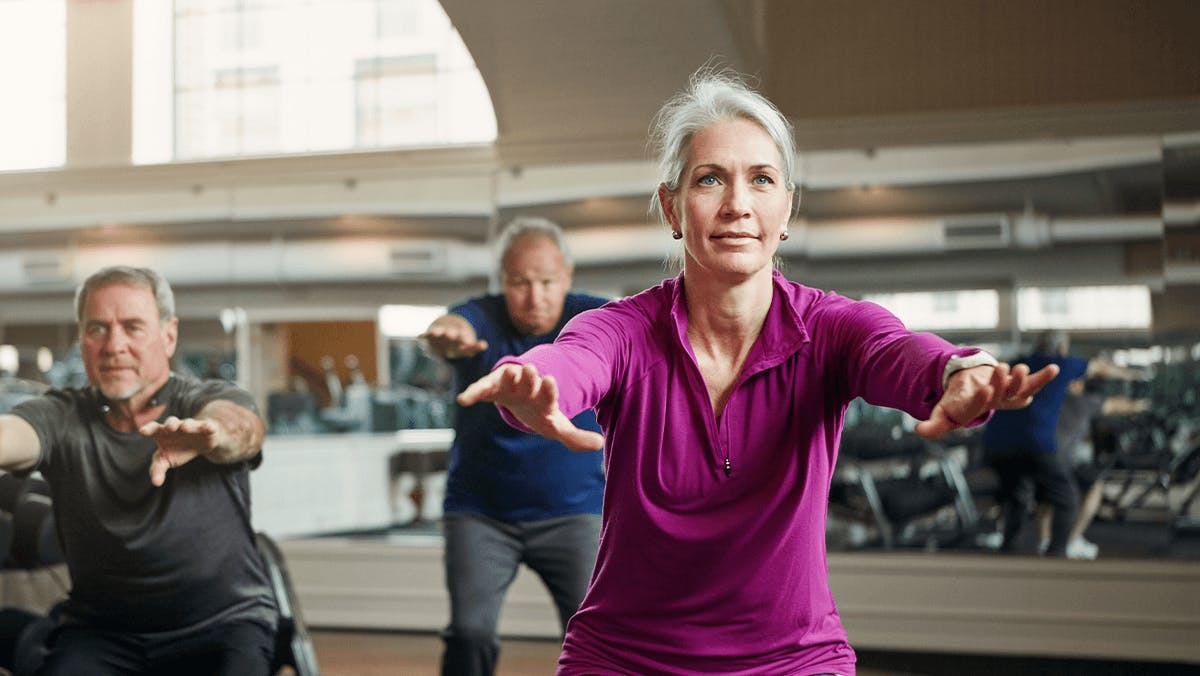Low Impact Exercises for Seniors

Physical activity is one of the most important things you can do to maintain your health, especially as you get older. If you’re 50 or older, even a single session of moderate to vigorous physical activity can provide immediate benefits to your overall health.[1] Learn how to stay active with low-impact movements like chair exercises, exercises for balance and stretching routines for seniors.
The Importance of Staying Active for Seniors
As we age, we experience a loss of both muscle mass (sarcopenia) and bone mass (osteopenia or osteoporosis).[2] This loss of physical mass can be linked to genetics and nutrition, but lifestyle has also been shown to be associated with these physical issues.[2]
Regular physical activity can help reduce the risk of developing many chronic diseases like heart disease, stroke and type 2 diabetes.[1] Research from the Centers for Disease Control has shown that physical activity can reduce the risk of developing dementia and Alzheimer's disease.[1]
Some of the immediate benefits of physical activity can include improved sleep quality, reduced feelings of anxiety and a reduction of blood pressure.[1]
Low-Impact Exercises for Maintaining Balance, Mobility and Core Strength
Low-impact exercises emphasize slow, steady, and deliberate movements.[3] By embracing this type of exercise, your body builds stamina, strength and muscle mass.[3] To reduce the risk of injury, start with lower-intensity activities that match your current fitness level.[4] Here are some exercises for seniors that require minimal equipment and target functional mobility:
Chair Exercises for Strength and Flexibility
Chair-based workouts can help you build and maintain strength and flexibility, especially if you have balance or mobility issues.[5] By using a chair as a stable base for exercise, you can alleviate or reduce pressure on knees or ankles.[5] Try these exercises for a combination of strength and flexibility:[5]
- Chair stand: Sit at the front of the chair with your knees bent and your feet flat on the floor. Slowly raise your upper body forward until you are sitting upright. Using your hands as little as possible, slowly sit back down and repeat.
- Seated hamstring stretch: Sit up straight near the front of a chair. Extend your right leg straight in front of you with your heel on the floor and your toes pointing upward. Hinge forward from your hip and hold for several seconds. Repeat with your left leg.
- Seated march: Sit up straight at the front of your chair and lift your left leg at the knee, then return it to the floor. Repeat with your right leg and continue to "march" in place for 15 to 20 seconds.
Gentle Stretches to Improve Balance and Mobility
Stretching helps your body move and bend more easily, which provides freedom of movement for other exercises and your day-to-day activities.[6] Focusing on balance can also reduce the chances of suffering a fall.[4] Try these stretches:[7]
- Chest stretch: Place your fingertips lightly on the back of your head. Then, push your elbows back while squeezing with your upper back. Hold for 20–30 seconds.
- Hip flexor stretch: Lunge forward with your left leg and your knee bent, while keeping your right leg straight or slightly bent. Next, push your hips forward until you feel a stretch in front of your back thigh near the groin. Hold 20–30 seconds, then repeat with your right leg.
- Shoulder rolls: Lift your shoulders up toward your ears, then down and backwards in a circular motion. Repeat 5–10 times. You can do this stretch with both shoulders at the same time or alternate sides.
Effective Exercises for Developing Core Strength
Your core muscles are vital to supporting your lower back and helping you stand, bend and maintain your balance.[8] When you lift heavy objects or climb up or down stairs, you’re working several core muscles at the same time—which is why it’s important to exercise the muscle groups that form your core at the same time.[8] Try these exercises and repeat each form 10 times for an effective routine:[8]
- Bridge: Lie on your back with your knees bent and feet flat on the floor. Next, tighten your buttocks and slowly lift your hips up off the floor. Hold, then return to the starting position.
- Modified plank: Start on your hands and knees. Tighten your abdominal muscles and lower your upper body onto your forearms. Keep your shoulders aligned over your elbows while keeping your feet in the air. Hold, then return to the starting position.
- Opposite arm and leg raise: Begin by kneeling on all fours. Then, extend your left leg off the floor behind you while reaching out in front of you with your right arm. Be sure to keep your hips and shoulders squared and your leg and arm parallel to the floor. Hold, then return to the starting position. Repeat with your right leg and left arm.
How Much Physical Activity Do I Need?
Low-impact exercise can easily fall into the range of moderate-intensity activity if your heart rate increases during your routine.[3] Most medical professionals recommend at least 150 minutes (2.5 hours total) per week of moderate-intensity activity, or 75 minutes per week of vigorous activity (or a combination of both) for adults that are generally healthy.[3][9] You should always seek advice from your healthcare professional regarding the fitness routine that is best for you and your needs and abilities.
Aerobic or cardio activity increases your heart rate, which helps to improve cardiovascular health.[9] Doing moderate-intensity activities increases your heart and breathing rate but still allows you to carry a normal conversation without losing your breath.[9] These activities include:[9]
- brisk walking (at least 2.5 miles per hour)
- cycling (slower than 10 miles per hour)
- water aerobics
- dancing
- gardening
Vigorous activities are more intensive and will induce sweating and shortness of breath.[9] These activities may involve:[9]
- jogging
- cycling (10 miles per hour or faster)
- hiking on varying terrain
- swimming laps
- heavy yardwork (such as digging or removing snow)
- jumping rope
- tennis
To get the most out of physical activity, the American Heart Association recommends increasing the amount and intensity of activity gradually over time.[9] Pair these activities with strengthening and stretching exercises and spread them throughout the week.[9] Speak with your healthcare provider about how to best increase the intensity of your exercise.
The Role of Centrum Silver in Overall Health
With essential vitamins and minerals, Centrum Silver for Adults 50+ plays a key role in helping to support overall health. The Centrum Silver formula includes magnesium, which supports healthy muscle function, and B-vitamins, which support daily energy needs. These adult multivitamins are specially formulated for adults over 50 years old to help you meet your nutritional requirements and support your body from head to toe.










